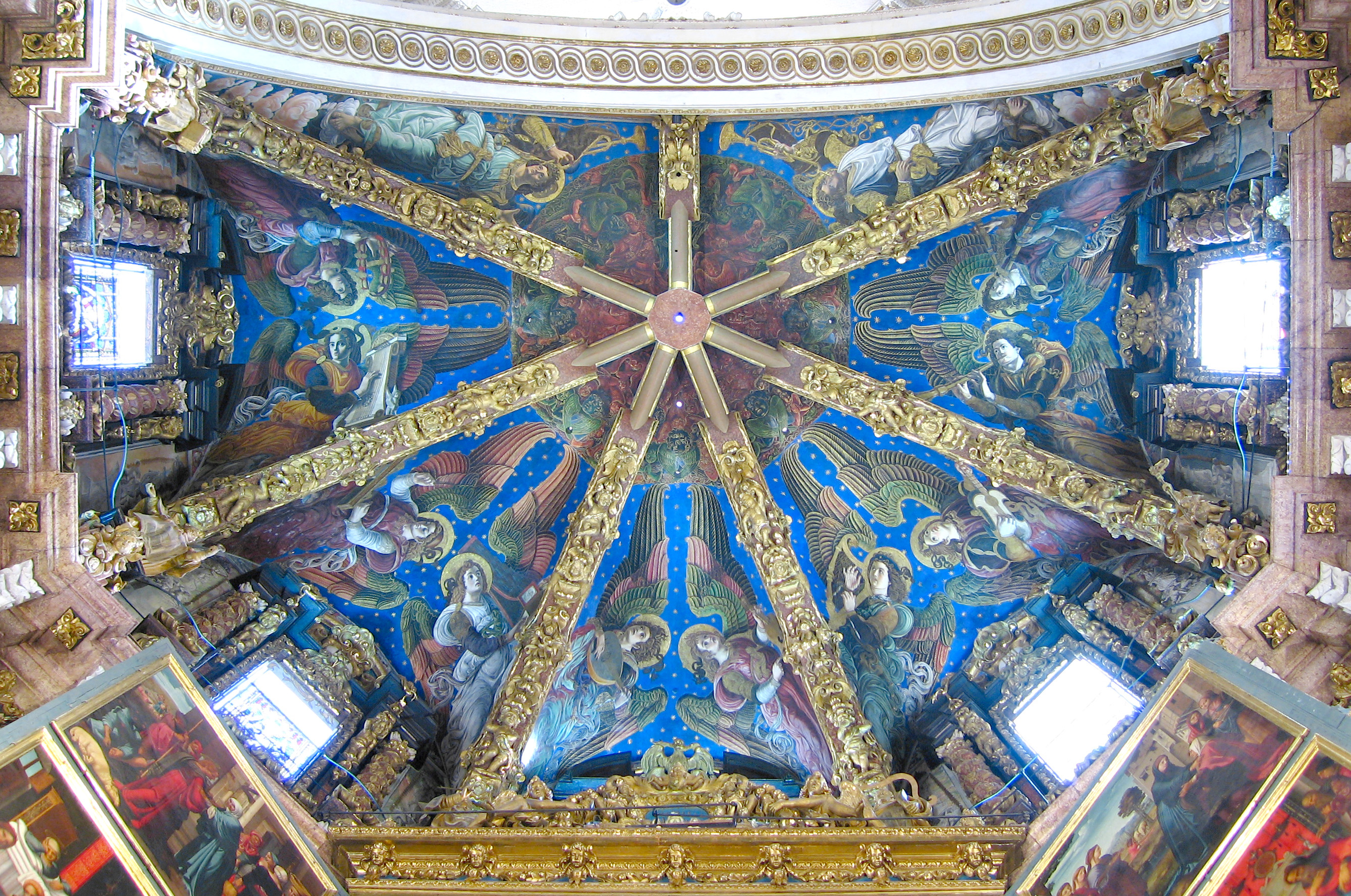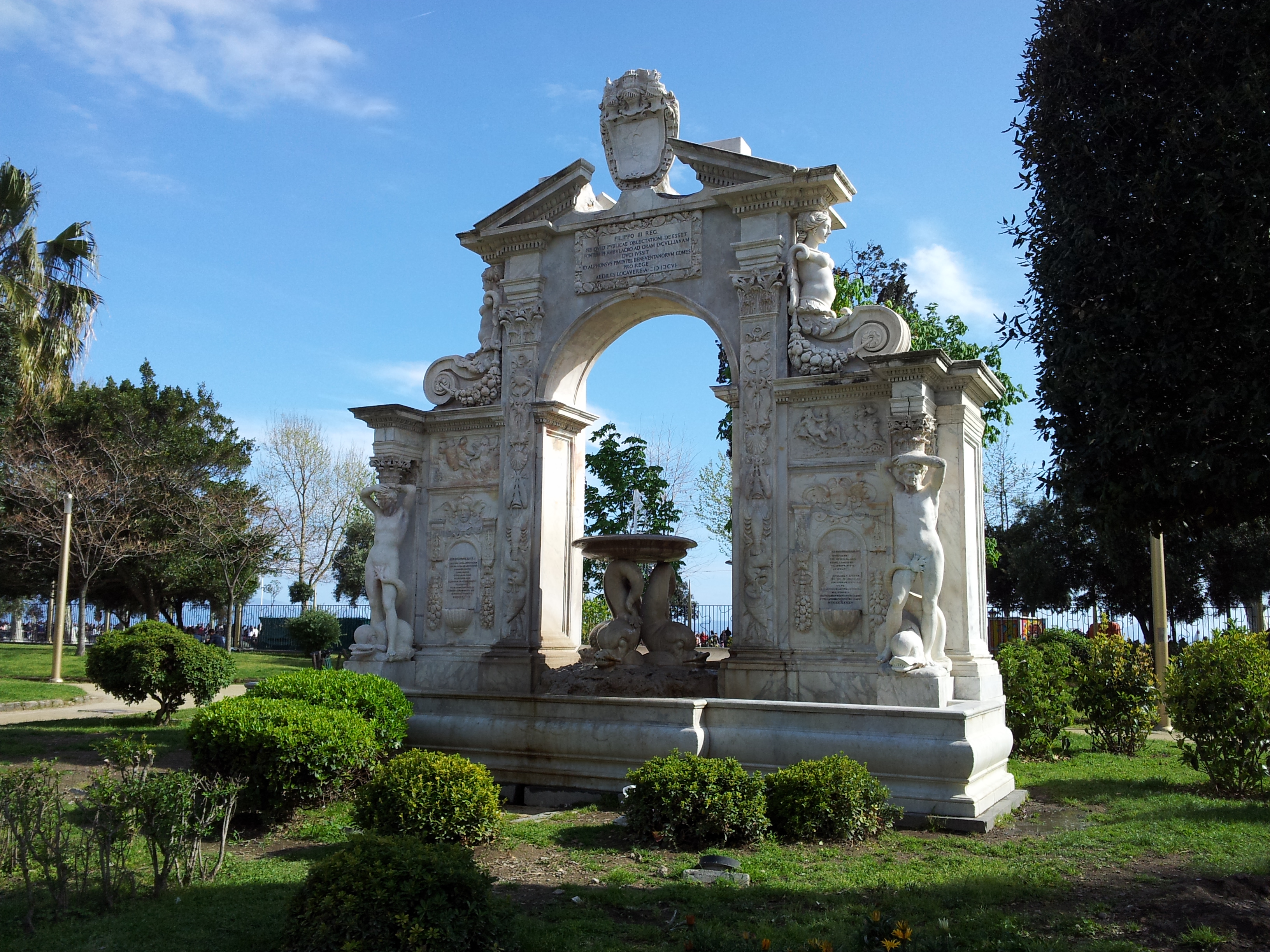|
Immacolatella
The Palace of the Immacolatella is a late Baroque style palace at water's edge in Naples, Italy. The palace design is attributed to the multifaceted painter, sculptor, and architect, Domenico Antonio Vaccaro and it was completed in 1740s to the quarantine station for the port of Naples. At the time, it stood on a peninsula connected to the mainland, connected through the church of Santa Maria del Portosalvo (Holy Mary of the Safe Haven). The area to the north was filled in the 1930s. The palace is so named because of the statue of the ''Immaculate Conception'' by Francesco Pagano, which stands on the roof line over the entrance. The famous Immacolatella fountain, now called Fountain of the Giant, was initially associated with the building, and designed by Michelangelo Naccherino. It was relocated and now stands on the seaside road, via Nazario Sauro, near the Castel dell'Ovo. Immacolatella Immacolatella The Palace of the Immacolatella is a late Baroque style palace at ... [...More Info...] [...Related Items...] OR: [Wikipedia] [Google] [Baidu] |
Domenico Antonio Vaccaro
Domenico Antonio Vaccaro (June 3, 1678 – June 13, 1745) was an Italian painter, sculptor and architect. He created many important sculptural and architectural projects in Naples. His later works are executed in an individualistic Rococo style.Alexander Kader and Antonia Boström. "Vaccaro." Grove Art Online. Oxford Art Online. Oxford University Press. Web. 7 Jun. 2016 Life Domenico Antonio Vaccaro was born in Naples as the son of Lorenzo Vaccaro. His father Lorenzo was a pupil of Cosimo Fanzago. Domenico Antonio Vaccaro first studied under his father. He subsequently trained in the workshop of Francesco Solimena. He initially dedicated himself to painting but from around 1707 he appears to have practised almost exclusively as a sculptor and architect. In the 1730s he resumed painting. Works of interest include a statue of ''Moses'' in the church of San Ferdinando, interior work at the Chiesa di Santa Maria in Portico, and the statues of ''Penitence'' and ''Solitude' ... [...More Info...] [...Related Items...] OR: [Wikipedia] [Google] [Baidu] |
Fontana Del Gigante, Naples
The Fontana del Gigante or Fountain of the Giant is a 17th-century monumental fountain in Naples. It was originally built adjacent to the Royal Palace of Naples, where it stood near a colossal ancient statue, and thereby gained its name. From there it was moved to the site of Palace of the Immacolatella, but in 1905, it was moved to it present picturesque site, on via Partenope, near the Castel dell'Ovo. It is also called the Fontana dell'Immacolatella. History The fountain was commissioned by the Spanish viceroy, Antonio Álvarez de Toledo, 5th Duke of Alba, and erected alongside the royal palace at the edge of the ''Largo di Palazzo'' (currently known as Piazza del Plebiscito), at a corner (currently the start of Via Cesario Console) where a colossal statue, known as ''il Gigante'' or Giant, had been erected. The statue coupled with the fountain can be seen in this location in some paintings from past centuries, including one by Gaspar van Wittel Caspar van Wittel or Gas ... [...More Info...] [...Related Items...] OR: [Wikipedia] [Google] [Baidu] |
Baroque Architecture
Baroque architecture is a highly decorative and theatrical style which appeared in Italy in the early 17th century and gradually spread across Europe. It was originally introduced by the Catholic Church, particularly by the Jesuits, as a means to combat the Reformation and the Protestant church with a new architecture that inspired surprise and awe. It reached its peak in the High Baroque (1625–1675), when it was used in churches and palaces in Italy, Spain, Portugal, France, Bavaria and Austria. In the Late Baroque period (1675–1750), it reached as far as Russia and the Spanish and Portuguese colonies in Latin America. About 1730, an even more elaborately decorative variant called Rococo appeared and flourished in Central Europe. Baroque architects took the basic elements of Renaissance architecture, including domes and colonnades, and made them higher, grander, more decorated, and more dramatic. The interior effects were often achieved with the use of ''quadratura'', or ... [...More Info...] [...Related Items...] OR: [Wikipedia] [Google] [Baidu] |
Naples
Naples (; it, Napoli ; nap, Napule ), from grc, Νεάπολις, Neápolis, lit=new city. is the regional capital of Campania and the third-largest city of Italy, after Rome and Milan, with a population of 909,048 within the city's administrative limits as of 2022. Its province-level municipality is the third-most populous metropolitan city in Italy with a population of 3,115,320 residents, and its metropolitan area stretches beyond the boundaries of the city wall for approximately 20 miles. Founded by Greeks in the first millennium BC, Naples is one of the oldest continuously inhabited urban areas in the world. In the eighth century BC, a colony known as Parthenope ( grc, Παρθενόπη) was established on the Pizzofalcone hill. In the sixth century BC, it was refounded as Neápolis. The city was an important part of Magna Graecia, played a major role in the merging of Greek and Roman society, and was a significant cultural centre under the Romans. Naples served a ... [...More Info...] [...Related Items...] OR: [Wikipedia] [Google] [Baidu] |
Santa Maria Del Portosalvo, Naples
Santa Claus, also known as Father Christmas, Saint Nicholas, Saint Nick, Kris Kringle, or simply Santa, is a legendary figure originating in Western Christian culture who is said to bring children gifts during the late evening and overnight hours on Christmas Eve of toys and candy or coal or nothing, depending on whether they are "naughty or nice". In the legend, he accomplishes this with the aid of Christmas elves, who make the toys in his workshop, often said to be at the North Pole, and flying reindeer who pull his sleigh through the air. The modern figure of Santa is based on folklore traditions surrounding Saint Nicholas, the English figure of Father Christmas and the Dutch figure of '' Sinterklaas''. Santa is generally depicted as a portly, jolly, white- bearded man, often with spectacles, wearing a red coat with white fur collar and cuffs, white-fur-cuffed red trousers, red hat with white fur, and black leather belt and boots, carrying a bag full of gifts for ... [...More Info...] [...Related Items...] OR: [Wikipedia] [Google] [Baidu] |
Francesco Pagano
Francesco Pagano, ( fl. 1471–1506) was an Italian painter working primarily in Spain. His date of birth is not known. Pagano was active in Valencia, and primarily painted religious-themed works for local churches. He is credited with helping import the Italian Renaissance style to Spain. In 1472 he was commissioned in conjunction with Paolo da San Leocadio by the papal envoy Rodrigo Borja, a Spaniard who became Pope Alexander VI, to paint the ceiling of the Valencia Cathedral. A false ceiling had hidden the fresco for more than 330 years, until an investigation into some pigeons led to the discovery. He also painted, in 1506, again in conjunction with Paolo da San Leocadio, the doors of the high altar of the cathedral, with subjects from the Life of the Virgin The Life of the Virgin, showing narrative scenes from the life of Mary, the mother of Jesus, is a common subject for pictorial cycles in Christian art, often complementing, or forming part of, a cycle on the Life of C ... [...More Info...] [...Related Items...] OR: [Wikipedia] [Google] [Baidu] |
Michelangelo Naccherino
Michelangelo Naccherino (Florence, March 6, 1550 – Naples, February, 1622) was an Italian sculptor and architect, active mainly in the Kingdom of Naples, Italy. He supposedly was a pupil of Giambologna in Florence, but due to disagreements moved to the Kingdom of Naples in 1573. From 1575-1577, he was active in Palermo, where he worked alongside Camillo Camilliani in the construction of the Fontana Pretoria, a project of Francesco Camilliani. Returning to Naples, he completed a number of Mannerist projects such as the tomb of Alfonso Sanchez (1588–89) in the Basilica of Santissima Annunziata Maggiore and a crucifix (1599) for the church of San Carlo all'Arena. He also completed a ''Madonna della Sanità'' for the church of Santa Maria della Sanità in the zone of Materdei, where he lived. In the early 1600s, he participated in a variety of projects, including the Fontana di Santa Lucia and the Fontana del Gigante (along with Pietro Bernini). In 1607, he su ... [...More Info...] [...Related Items...] OR: [Wikipedia] [Google] [Baidu] |
Castel Dell'Ovo
Castel dell'Ovo ("Egg Castle") is a seafront castle in Naples, located on the former island of Megaride, now a peninsula, on the Gulf of Naples in Italy. The castle's name comes from a legend about the Roman poet Virgil, who had a reputation in the Middle Ages as a great sorcerer and predictor of the future. In the legend, Virgil put a magical egg into the foundations to support the fortifications. It remains there along with his bones, and had this egg been broken, the castle would have been destroyed and a series of disastrous events for Naples would have followed. The castle is located between the districts of San Ferdinando and Chiaia, facing Mergellina across the sea. History during the Roman era The Castel dell'Ovo is the oldest castle in Naples. The island of Megaride was where Greek colonists from Cumae founded the original nucleus of the city in the 6th century BC. Its location offers an excellent view of the Naples waterfront and the surrounding area. In the 1st ... [...More Info...] [...Related Items...] OR: [Wikipedia] [Google] [Baidu] |
18th-century Establishments In Italy
The 18th century lasted from January 1, 1701 ( MDCCI) to December 31, 1800 ( MDCCC). During the 18th century, elements of Enlightenment thinking culminated in the American, French, and Haitian Revolutions. During the century, slave trading and human trafficking expanded across the shores of the Atlantic, while declining in Russia, China, and Korea. Revolutions began to challenge the legitimacy of monarchical and aristocratic power structures, including the structures and beliefs that supported slavery. The Industrial Revolution began during mid-century, leading to radical changes in human society and the environment. Western historians have occasionally defined the 18th century otherwise for the purposes of their work. For example, the "short" 18th century may be defined as 1715–1789, denoting the period of time between the death of Louis XIV of France and the start of the French Revolution, with an emphasis on directly interconnected events. To historians who expand the ... [...More Info...] [...Related Items...] OR: [Wikipedia] [Google] [Baidu] |
Palaces In Naples
A palace is a grand residence, especially a royal residence, or the home of a head of state or some other high-ranking dignitary, such as a bishop or archbishop. The word is derived from the Latin name palātium, for Palatine Hill in Rome which housed the Imperial residences. Most European languages have a version of the term (''palais'', ''palazzo'', ''palacio'', etc.), and many use it for a wider range of buildings than English. In many parts of Europe, the equivalent term is also applied to large private houses in cities, especially of the aristocracy; often the term for a large country house is different. Many historic palaces are now put to other uses such as parliaments, museums, hotels, or office buildings. The word is also sometimes used to describe a lavishly ornate building used for public entertainment or exhibitions such as a movie palace. A palace is distinguished from a castle while the latter clearly is fortified or has the style of a fortification, wherea ... [...More Info...] [...Related Items...] OR: [Wikipedia] [Google] [Baidu] |

_e_San_Martino%2C_Napoli%2C1799.jpg)





